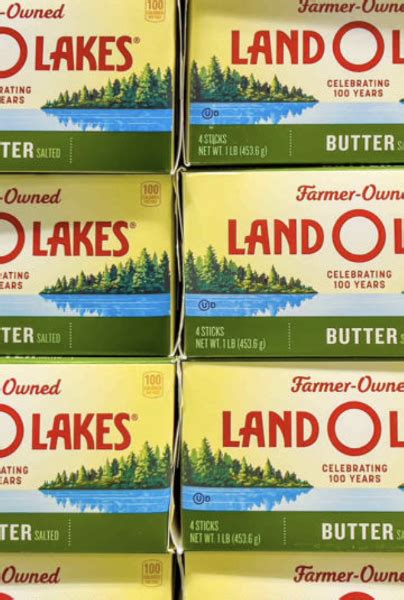
Land O’ Lakes suggests that butter’s ideal storage method hinges on frequency of use: keep it on the counter in a covered butter dish for immediate access or in the refrigerator, well-wrapped, for longer preservation, clarifying a common kitchen conundrum and debunking the myth of a singular “only” way.
Butter, a staple in kitchens worldwide, often finds itself at the center of storage debates. Land O’ Lakes, a prominent dairy company, has weighed in on the optimal way to store this versatile ingredient, emphasizing a nuanced approach that depends largely on usage habits. Their guidance challenges the notion of a one-size-fits-all solution, advocating instead for a method tailored to how quickly the butter will be consumed. This clarification comes as a welcome relief to home cooks and culinary enthusiasts seeking to maintain butter’s quality and flavor.
The key takeaway from Land O’ Lakes’ advice is the consideration of frequency. For those who use butter regularly, keeping it at room temperature in a covered butter dish is perfectly acceptable, even preferable. This allows the butter to remain soft and spreadable, ideal for toast, sandwiches, and quick culinary applications. However, the company stresses the importance of using a proper butter dish – one that is opaque and tightly sealed. The opacity prevents light from degrading the butter, while the tight seal protects it from air and odors, both of which can negatively impact flavor. Land O’ Lakes recommends storing only the amount of butter you expect to use within a few days at room temperature.
For those who don’t use butter as frequently, refrigeration is the recommended method. However, simply tossing a stick of butter into the refrigerator unprotected is a recipe for disaster. Butter readily absorbs flavors and odors from its surroundings, leading to a less-than-desirable taste. To prevent this, Land O’ Lakes advises wrapping the butter tightly in its original packaging, followed by an additional layer of protection, such as plastic wrap or a resealable bag. This double layer acts as a barrier against unwanted flavors and helps to maintain the butter’s freshness. Properly stored in the refrigerator, butter can maintain its quality for weeks, even months.
The distinction between these two storage methods hinges on several factors, including temperature, light exposure, and air exposure. At room temperature, butter’s fat molecules soften, making it easier to spread. However, this softening also makes it more susceptible to rancidity, a process caused by the oxidation of fats. Light accelerates this oxidation process, while exposure to air introduces microbes that can contribute to spoilage. Therefore, a covered butter dish is essential for mitigating these risks.
In the refrigerator, the lower temperature slows down the rate of oxidation and microbial growth, extending the butter’s shelf life. However, the refrigerator’s environment is also filled with a variety of strong odors from other foods. Butter’s high fat content makes it particularly absorbent, which is why proper wrapping is crucial.
The Land O’ Lakes guidance also touches upon the type of butter being stored. Salted butter, due to its salt content, generally has a longer shelf life than unsalted butter. Salt acts as a preservative, inhibiting the growth of microorganisms. Therefore, unsalted butter may require slightly more diligent storage practices to maintain its quality.
It is important to note that while Land O’ Lakes is a well-respected name in the dairy industry, their advice aligns with the recommendations of numerous food safety experts and culinary professionals. Organizations like the USDA (United States Department of Agriculture) also provide guidelines on butter storage, emphasizing the importance of refrigeration for extended shelf life and proper wrapping to prevent flavor absorption.
Beyond the practical aspects of storage, there’s also a sensory element to consider. Butter’s flavor is complex and nuanced, influenced by factors such as the cow’s diet, the processing methods used, and even the time of year. Improper storage can diminish these subtle qualities, resulting in a bland or even off-putting taste. By following Land O’ Lakes’ recommendations, consumers can ensure that their butter retains its optimal flavor profile, enhancing the overall culinary experience.
The debate over butter storage methods is a testament to the importance of proper food handling practices. While seemingly simple, the way we store our ingredients can have a significant impact on their quality, safety, and flavor. By understanding the factors that contribute to spoilage and following the advice of trusted sources like Land O’ Lakes, we can all become more informed and effective cooks. The company’s stance underscores that there isn’t one singular answer to butter storage, but rather, a flexible approach that caters to individual needs and consumption patterns.
In addition to the basic storage guidelines, Land O’ Lakes also offers advice on identifying signs of spoilage. Rancid butter will often have an off odor, a yellowish tinge on the surface, and a sour or bitter taste. If butter exhibits any of these characteristics, it should be discarded. While it may be tempting to simply cut off the affected portion, the underlying rancidity likely permeates the entire stick.
Furthermore, the texture of butter can also be an indicator of its quality. Butter that has been improperly stored may become overly soft and greasy, or conversely, hard and crumbly. These textural changes can affect its performance in baking and cooking.
Land O’ Lakes also addresses the question of freezing butter. While freezing is an effective way to preserve butter for extended periods, it’s important to wrap it tightly to prevent freezer burn. Freezer burn occurs when moisture evaporates from the surface of the butter, leading to a dry, leathery texture. Properly wrapped butter can be stored in the freezer for several months without significant loss of quality. When thawing frozen butter, it’s best to do so gradually in the refrigerator to minimize condensation and maintain its texture.
Ultimately, the “only” way to store butter, as Land O’ Lakes emphasizes, is to consider how frequently you use it. If you’re a daily butter user, a covered dish on the counter is your best bet. If you use it less often, the refrigerator, with proper wrapping, is the way to go. This pragmatic approach ensures that your butter remains fresh, flavorful, and ready to enhance your favorite dishes. The key is not rigidity but adaptation to your culinary habits and environment.
The conversation extends beyond personal preference to include broader implications for food waste reduction. Correct storage prolongs the life of butter, reducing the likelihood of premature spoilage and subsequent disposal. In a world increasingly conscious of sustainability, minimizing food waste is a significant consideration. By adopting informed storage practices, consumers contribute to a more responsible and efficient food system.
It is equally important to consider the type of butter dish used when opting for counter storage. Ceramic or porcelain dishes with tight-fitting lids are generally recommended. These materials are non-reactive, meaning they won’t impart any unwanted flavors to the butter. Glass dishes can also be used, but they should be opaque or kept in a location away from direct sunlight. Avoid using plastic butter dishes, as they may absorb odors and can potentially leach chemicals into the butter.
Another aspect to consider is the climate in which you live. In warmer climates, butter may soften too quickly at room temperature, even in a covered dish. In such cases, refrigeration may be the more practical option, regardless of how frequently you use butter. Conversely, in cooler climates, butter may remain too hard in the refrigerator, making it difficult to spread. In these situations, keeping a small amount of butter in a covered dish on the counter and storing the rest in the refrigerator may be the ideal solution.
The importance of airtight containers cannot be overstressed. Exposure to air is a major contributor to butter spoilage, leading to oxidation and the development of off-flavors. An airtight container minimizes this exposure, helping to maintain the butter’s freshness and flavor. When using the refrigerator, consider placing the wrapped butter in an additional resealable bag for added protection.
Land O’ Lakes’ advice resonates with chefs and food professionals who prioritize quality and flavor in their creations. These experts understand that even seemingly minor details, such as proper butter storage, can have a significant impact on the final outcome of a dish. By adhering to best practices, they ensure that their butter remains at its peak performance, contributing to the overall success of their culinary endeavors.
The broader food industry benefits from clear guidance on butter storage. Retailers, distributors, and manufacturers all play a role in ensuring that butter reaches consumers in optimal condition. By promoting proper storage practices, they can help to maintain the quality of their products throughout the supply chain. This, in turn, builds consumer trust and satisfaction.
Butter, in its various forms, is a versatile ingredient with a rich history and cultural significance. From traditional baking to modern cuisine, it plays a vital role in countless recipes. By taking the time to store butter properly, we not only preserve its quality and flavor but also honor its place in our culinary heritage. Land O’ Lakes’ simple yet effective advice serves as a reminder that even the most basic ingredients deserve our attention and care. Their updated guidance provides clarity in a world of conflicting information, empowering consumers to make informed decisions about butter storage. This straightforward and adaptable approach ensures that everyone can enjoy the best possible butter experience, regardless of their culinary habits or geographical location.
Frequently Asked Questions (FAQ)
-
Is it safe to leave butter on the counter? Yes, according to Land O’ Lakes, it is safe to leave butter on the counter if you use it frequently and store it properly. They recommend using a covered butter dish that is opaque and tightly sealed to protect the butter from light, air, and odors. “For those who use butter regularly, keeping it at room temperature in a covered butter dish is perfectly acceptable, even preferable. This allows the butter to remain soft and spreadable.” However, only store the amount you’ll use within a few days to maintain optimal freshness.
-
How should I store butter in the refrigerator? Land O’ Lakes advises wrapping the butter tightly in its original packaging, followed by an additional layer of protection, such as plastic wrap or a resealable bag. “To prevent this, Land O’ Lakes advises wrapping the butter tightly in its original packaging, followed by an additional layer of protection, such as plastic wrap or a resealable bag. This double layer acts as a barrier against unwanted flavors and helps to maintain the butter’s freshness.” This double layer prevents the butter from absorbing flavors and odors from other foods in the refrigerator.
-
How long can butter last in the refrigerator? Properly stored in the refrigerator, butter can maintain its quality for weeks, even months. The key is to ensure it is well-wrapped to prevent it from absorbing odors and flavors from other foods.
-
How can I tell if butter has gone bad? Rancid butter will often have an off odor, a yellowish tinge on the surface, and a sour or bitter taste. The texture of the butter can also be an indicator; butter that has been improperly stored may become overly soft and greasy, or conversely, hard and crumbly. According to Land O’ Lakes, “Rancid butter will often have an off odor, a yellowish tinge on the surface, and a sour or bitter taste.” If the butter exhibits any of these characteristics, it should be discarded.
-
Can I freeze butter? Yes, freezing is an effective way to preserve butter for extended periods. Land O’ Lakes recommends wrapping it tightly to prevent freezer burn, which occurs when moisture evaporates from the surface, leading to a dry, leathery texture. “While freezing is an effective way to preserve butter for extended periods, it’s important to wrap it tightly to prevent freezer burn.” Properly wrapped butter can be stored in the freezer for several months without significant loss of quality. When thawing, do so gradually in the refrigerator.
-
Does salted or unsalted butter last longer? Salted butter generally has a longer shelf life than unsalted butter. The salt acts as a preservative, inhibiting the growth of microorganisms.
-
What type of butter dish is best for counter storage? Ceramic or porcelain dishes with tight-fitting lids are generally recommended. These materials are non-reactive, meaning they won’t impart any unwanted flavors to the butter. Glass dishes can also be used, but they should be opaque or kept away from direct sunlight. Avoid using plastic butter dishes.
-
Why is it important to keep butter away from light? Light accelerates the oxidation process of butter’s fat molecules, leading to rancidity. This is why an opaque butter dish is recommended for counter storage.
-
What factors contribute to butter spoilage? Exposure to air, light, and warm temperatures contribute to butter spoilage. Air leads to oxidation, light accelerates oxidation, and warm temperatures promote microbial growth and softening.
-
Does climate affect how I should store butter? Yes, in warmer climates, butter may soften too quickly at room temperature, even in a covered dish, making refrigeration the more practical option. Conversely, in cooler climates, butter may remain too hard in the refrigerator, suggesting that keeping a small amount on the counter might be ideal.
-
What are the benefits of storing butter properly? Proper storage preserves the butter’s quality, flavor, and texture, extends its shelf life, reduces food waste, and ensures that it performs optimally in cooking and baking.
-
What should I do if my butter has absorbed odors from the refrigerator? Unfortunately, once butter has absorbed odors, it’s difficult to remove them. Prevention is key, which is why proper wrapping is crucial. If the odor is slight, you might try using the butter in recipes with strong flavors that can mask the unwanted taste.
-
Can I use a microwave to soften butter? While you can use a microwave to soften butter, it’s easy to overdo it, resulting in melted butter. If using a microwave, use very short intervals (5-10 seconds) and monitor closely.
-
Is it necessary to use a butter dish with a tight-fitting lid? Yes, a tight-fitting lid is essential for protecting the butter from air and odors, which can negatively impact its flavor.
-
What is freezer burn, and how can I prevent it? Freezer burn occurs when moisture evaporates from the surface of the butter, leading to a dry, leathery texture. To prevent it, wrap the butter tightly in multiple layers of plastic wrap or foil before freezing.
-
Are there any differences in storing different types of butter, like European-style butter? European-style butter, which typically has a higher butterfat content, may be slightly more resistant to spoilage due to its lower water content. However, the same storage principles apply: protect it from light, air, and odors.
-
How does storing butter on the counter affect its performance in baking? Counter-stored butter is softer and easier to cream with sugar, which is important for many baking recipes. However, if the recipe requires cold butter, you’ll need to refrigerate it beforehand.
-
Is it better to store butter in the back or the front of the refrigerator? It’s generally better to store butter in the back of the refrigerator, where the temperature is more consistent and colder. Avoid storing it in the refrigerator door, as the temperature fluctuates more frequently.
-
Should I store butter in its original packaging? Yes, Land O’ Lakes recommends keeping butter in its original packaging and adding an extra layer of protection, such as plastic wrap or a resealable bag, for optimal storage.
-
If I have a large quantity of butter, is it best to store it all in the freezer? If you have a large quantity of butter that you won’t use within a few weeks, freezing is a good option for long-term storage. Divide the butter into smaller portions before freezing to make it easier to thaw only what you need. Make sure each portion is properly wrapped.









